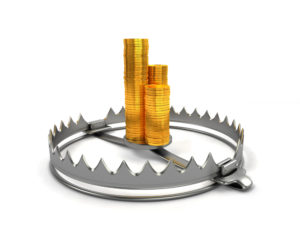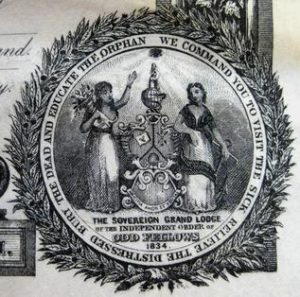Can We Have Welfare Without the Threat of Violence?
By Max Borders


Most grownups don’t believe in magic anymore. Sometimes, though, it can be helpful to imagine it. A powerful ring turns the wearer invisible in J. R. R. Tolkien’s The Lord of the Rings. That power means the wearer can act with relative impunity. (For that device, Tolkien had Plato to thank.)
We can also imagine characters with superhuman abilities. These thought experiments sometimes help us put ourselves and our societies into perspective. In Tolkien’s world, we wrestle with questions on the nature of power. In our world, we can explore the nature of peace.
Let’s imagine that wizards exist in our world, and one supremely powerful wizard has cast a spell over the realm.
The Spell of Nonviolence
The wizard’s spell is of nonviolence. Call it “The Spell of Ahimsa.” Under this spell, no one can threaten or commit any act that injures another person or their property. When a brigand tries to attack a caravan on the road, his fingers weaken, and his dagger simply falls from his grasp. When a tax collector tries to arrest a merchant in the town, the handcuffs slip from his fingers. When a bully tries to push another girl, she discovers an invisible wall of protection. It doesn’t matter whether the perpetrator thinks he is using violence to serve good or evil. The fact is, the spell ensures a condition of complete nonviolence in society.
What should we make of this? Would the realm be better off under the wizard’s spell?
Answers will vary. Nearly every society has laws against theft, fraud, and physical injury, which means something is justifiable about the spell. So at least a fair number of people might agree intuitively that the world would be better without violence. As soon as we get into questions about the justification for authority’s threats of violence, though, answers start to diverge.
Differences are starkest when we think of the spell affecting government officials. Consider “The Spell of Nonviolence” as it relates to issues of government-issued welfare. In other words, if the wizard used magic such that officials had to abstain from violence, how would authorities implement redistribution schemes? Specifically, how would authorities tax the rich to give to the poor?
Redistribution as Rooted in Violence
The modern redistributive state is relatively recent in history. In fact, what made the welfare state affordable was the rapid advances of industry and enterprise. After about 1800, this advance—known as the “hockey stick” of prosperity—helped generate opportunities for people to create more value for each other. For maybe the first time in history, there were more people trading than raiding. People living in this Great Enrichment rocketed out of poverty.1
According to economic historian Dierdre McCloskey:,
- Earlier prosperities had intermittently increased real income per head by double or even triple, 100 or 200 percent or so, only for it to fall back to the miserable $3 a day typical of humans since the caves. But the Great Enrichment increased real income per head, in the face of a rise in the number of heads, by a factor of seven—by anything from 2,500 to 5,000 percent.
A few entrepreneurs got amazingly wealthy in the Great Enrichment, but a massive middle class emerged, too, as people figured out how to organize themselves into productive firms. These firms weren’t perfect, but they were responsible for unprecedented improvements in living standards. With such gains, even the poorest improved their lot.
In the late nineteenth and early twentieth centuries, governments began instituting welfare programs and other centralized forms of social welfare. The idea was to see that the least fortunate in society could meet their basic needs. But these systems brought along a set of perverse consequences. And as these systems began to predominate, existing voluntary systems of civil society disappeared. Essential features of voluntary systems, such as the practice of compassion and community, not to mention the development of personal responsibility, slowly disappeared along with them.
The Spell of Ahimsa helps us see a feature of the redistributive welfare state that is frequently overlooked: its very existence depends on state-sanctioned violence. In other words, how would the system operate if authorities couldn’t threaten to imprison those who refused to pay for it?
Most people don’t think about matters this way, accustomed to the idea of the welfare state as a permanent fixture of life. But as we will see, it hasn’t always been this way. Human beings naturally organize themselves.
Savings Clubs Around the World
Tanomoshi is a locally organized system of mutual aid. These community resource pools have existed in Japan at least since the middle Kamakura period of 1185 to 1333 BCE. Under this system, each member would contribute a small sum at regular intervals and would receive a single, lump payment whenever the member experienced a significant life event.
In medieval Japan, per capita GDP is estimated to have been between 500 and 800 dollars in 2011 dollars. (Compare this with today’s United States poverty level of $12,880 for a single person.) Every month, people would travel to the tanomoshiko to leave a little bit of money. A trusted party there would accept their contribution with a bow. Tanomoshiko is translated as “reliable group,” so the community selected a steward of integrity. Though most medieval Japanese earned very little, they were committed. One family might have arranged for a daughter to be married. Another might have found a parent has become gravely ill. Each would be able to go directly to the tanomoshiko for support.
In some of the poorest parts of the world, there is little capacity for government welfare, much less modern banking. So in places like sub-Saharan Africa, people contribute a modest monthly allotment to a su su (or sou-sou). Those who aren’t very good at saving money by themselves are encouraged to use a su su because club members hold one another accountable.
Here’s how it works, according to South African writer Lihle Z. Mtshali, describing the Afro-Caribbean variant in America:
- The group elects a treasurer who will collect the members’ contributions. She will also create a payout roster, or members can request to receive their hand at any given date during the cycle. Everyone agrees on how much and how often they want to contribute. If ten members are contributing $100 a week, each week a member will receive a $1,000 hand or cash lump sum. The cycle begins again after ten weeks. Any member who can afford it, can also double their contribution and get paid two hands in one cycle.2
Because there is no interest to be collected, members always get out the exact amount they put in. The recipient changes each period in a rotating fashion such that every member of the group is eventually a recipient.
Curiously, this arrangement has sprung up in various forms worldwide throughout history.
A similar system called kye in Korea is still around today, even among Korean immigrants to the United States. Similar rotational systems include tandas (Latin America), cundinas (Mexico), partnerhand (Caribbean/United Kingdom), hui (Asia), Game’ya (Middle East), pandeiros (Brazil), and arisan (Indonesia). These systems facilitate personal savings, investment in property and enterprise, insurance, personal loans, and assistance to poorer people. In developed countries, people can use these systems to build credit.
Mutual Aid in America

Today, if you were to ask the average man or woman on the street to name a mutual aid society, you would be lucky if he or she could name a single one. But at one time in America these organizations were everywhere. They had funny names like the Oddfellows, the Free African Society, and the Brotherhood of Locomotive Engineers. At one time, they included health insurance and unemployment support. Because they were a mix of the communitarian and the charitable, surplus dues could go to growth and giving. As most organized into local chapters and lodges, they featured the undocumented acts of kindness and tough love we would scarcely recognize if we saw them today. They are the forgotten social safety net.
This vast empire of human good was built not by federal largesse but on the moral conviction of free people weaving their lives together as a community to guard against hardship. Once held together by tight neighborhoods, mutual support, and barn raisings, a communitarian society has been torn apart by redistribution. Beholden to banks or bureaucracies, most Americans are dependent on authorities’ plans thousands of miles away. The rest are compelled to foot the bill—or else. At one stage, this system was affordable. But in time, the system became corrosive and dependent on public and private debt.
As we have fallen deeper into debt, we have forgotten how to take care of one another. The rise of the administrative welfare state corresponds to civil society’s decline. Whether it’s correlation or causation, I cannot say. But the circumstantial evidence is pretty damning.
The Decline of Community
When Alexis de Tocqueville came to America in 1831, he saw something profound. Maybe you’ve read the following passage before. But as you read it again, ask yourself whether or to what degree this is an America you recognize:
- The political associations that exist in the United States are only a single feature in the midst of the immense assemblage of associations in that country. Americans of all ages, all conditions, and all dispositions constantly form associations. They have not only commercial and manufacturing companies, in which all take part, but associations of a thousand other kinds, religious, moral, serious, futile, general or restricted, enormous or diminutive. The Americans make associations to give entertainments, to found seminaries, to build inns, to construct churches, to diffuse books, to send missionaries to the antipodes; in this manner they found hospitals, prisons, and schools. If it is proposed to inculcate some truth or to foster some feeling by the encouragement of a great example, they form a society. Wherever at the head of some new undertaking you see the government in France, or a man of rank in England, in the United States you will be sure to find an association.
I suspect that if you see today’s America in the above, it’s been weakened and politicized.
Reading Tocqueville, one can imagine a time when the organs of civil association extended to spheres of life such as childhood and old age. But these are institutionalized and segregated today. Children are warehoused by the state so that parents can work to pay bills and taxes. The elderly are similarly warehoused and told more or less that their participation in productive society is optional after age 65. Beyond that point, many become liabilities to be managed by the Congressional Budget Office.
Consider then the lost array of mutual aid societies, lodges, and fraternal orders of which a third of Americans were once members. Historian David Beito painstakingly investigates3 a handful of these to offer a clearer picture:
- The record of five societies that thrived at or near the turn of the century illustrates the many variants of this system. Each had a distinct membership base. Two of the societies, the Independent Order of Saint Luke and the United Order of True Reformers, were all-black. Both had been founded by ex-slaves after the Civil War and specialized initially in sickness and burial insurance. The other societies had entirely white memberships. The Loyal Order of Moose was an exclusively male society that emphasized sickness and burial benefits. It became best known during the 20th century for its orphanage, Mooseheart, near Aurora, Illinois. The Security Benefit Association (originally the Knights and Ladies of Security) followed in a similar tradition but broke from the mainstream by allowing men and women to join on equal terms.
Even as we shake our modern heads at segregation along racial lines, we can still appreciate the power of civil association that has all-but-disappeared in the twenty-first century.
There is no doubt that most human beings care for others. This care can extend to strangers. At some level, we all want to be assured that poor people can get help when they need it. Most of us want to know that those who seek our help really need it and that assistance doesn’t create dependency. Mutual aid societies served this function because members kept an eye on other members.
Government welfare views successful people as human ATMs and the poor as statistical plot points. There is no discernment. A mutual aid renaissance would discourage people from simply outsourcing their compassion. Instead, we would all have to learn to be compassionate again.
The Fundamental Questions
In an age of rapid technological advances and material abundance, we must ask penetrating questions about whether the current socio-political order is morally justifiable.
First, if you could choose non-violent means of achieving social goals such as poverty relief, wouldn’t you? After all, violence causes suffering. Causing unnecessary suffering against innocent people is wrong.
One might respond by arguing that non-violent forms of poverty relief are impossible, so the extent to which the relatively well-off suffer from taxation is a necessary evil. But isn’t this line of argument just a failure of imagination?
Remember that mutual aid was robust in the past without the benefits of modern technology. It’s easier to dispel skepticism about voluntary arrangements when we reflect on mutual aid in the era of digital ledgers. (Remember, we haven’t yet discussed improvements to the charity sector that the Internet has enabled.)
Now, if we can demonstrate that mutual aid and charity could be robust enough to help the least advantaged, wouldn’t that mean the violent redistributive state causes unnecessary suffering?
Advocates for the welfare state argue that wealthier members of society don’t suffer all that much when authorities compel them through redistributive taxation. But if we agree that the goal is to help the poor rather than punish the rich, then all such suffering is unnecessary. Moreover, the vast majority of the rich’s assets don’t go to consumption but rather to capital that fuels other poverty-fighting endeavors such as investments in companies and a thousand experiments in effective altruism.
Capital is rarely idle–passing over, for now, the perverse distortions created by central banks.
Finally, if it’s possible to help the poor (or the poor to help each other) without resorting to violence, isn’t this something we ought to do? If the answer is yes, we have a moral obligation to transition away from the violent welfare state to a nonviolent condition of community support, charity, and mutual aid. Sadly, moral suasion isn’t likely to work. But if governments around the world find they can no longer afford the bloat and unprecedented debt, it could be that mutual aid is the last remaining option.
Becoming the Social Safety Net
We have demonstrated that mutual aid is possible and probably more effective even among the poorest people. Even if a subset cannot afford to participate in mutual aid, the least advantaged would be able to rely more on families, churches, charities, and communities, all of which would likely receive greater comparative support. Again, the poor are more likely to find these options without a vast government welfare empire. In 1900, when U.S. per capita GDP was only $4,000, one-third of American men belonged to a mutual-aid society. Just think what this sector could look like with an average per capita GDP of $65,000—with only about 11 percent living below the federal poverty limit.
Mutual aid arrangements are not just superior because they are voluntary. These systems build in mechanisms of accountability and integrity for members—the practice of compassion. By contrast, government welfare is impersonal and treats everyone the same, reducing incentives to work and engendering an unhealthy sense of entitlement.
Again, the debt spending that is needed continuously to prop up the welfare system has created risks of a global contagion.
For more on these topics, see
- Welfare, by Jeffrey M. Jones and Thomas MaCurdy. Concise Encyclopedia of Economics.
- Charity, by Russell Roberts. Concise Encyclopedia of Economics.
 Christy Ford Chapin on the Evolution of the American Health Care System. EconTalk.
Christy Ford Chapin on the Evolution of the American Health Care System. EconTalk.- Democracy in America, by Alexis de Tocqueville. English Edition. 2 vols. Online Library of Liberty.
The mutual aid sector is thus due for a renaissance. It might seem radical, but charity and mutual aid systems create more trust, engender more integrity, and offer greater responsibility. Suppose, though, that the compulsory redistribution system continues to grow. There will be fewer opportunities for experimentation in mutual aid, that is, until the economy drowns in a sea of red ink.
Casting the Spell
Of course, there is no Spell of Nonviolence. It is impossible to cast such a spell on everyone. But one thing is possible: You and I can cast this spell on ourselves.
We can form a moral community of people who refuse to support institutions that threaten violence to operate. I’d be willing to bet that where there is more peace, there is also more compassion. As more people cast this spell upon themselves, we will find we live in a world of increased dignity, flourishing, and love.
Footnotes
[1] Deirdre McCloskey, “The Great Enrichment Was Built on Ideas, Not Capital.” FEE, Nov. 22, 2017.
[2] Lihle Z. Mtshali, “Everything You Ever Wanted to Know About Those Sou-Sou Savings Clubs African and Caribbean Women Love.” Essence, December 6, 2020.
[3] David T. Beito, From Mutual Aid to the Welfare State: Fraternal Societies and Social Services, 1890-1967. University of North Carolina Press, 2000.
* Max Borders is author of The Decentralist and The Social Singularlity.
For more articles by Max Borders, see the Archive.
